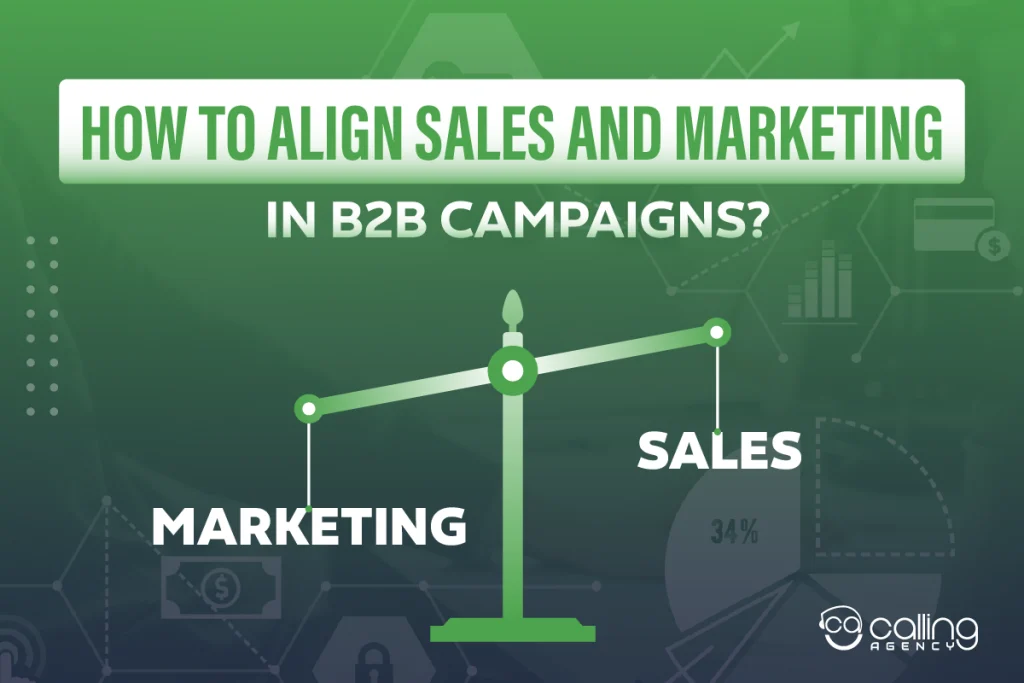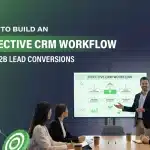B2B sales are naturally complex as they involve your various decision-makers, longer sales cycles, and higher price points compared to B2C transactions. This complexity makes your alignment between sales and marketing more crucial for your B2B company’s success.
Sales and marketing alignment is basically your strategic combination and collaboration between sales and marketing teams. Together, they can work within an alignment framework to define shared goals and key metrics, implement a closed-loop feedback, foster transparent communication, and more.
They can also improve your customers’ entire journey and generate more revenue for your company by using Smarketing tactics that merge sales and marketing efforts and a combined technology stack.
Let’s explore why sales and marketing are necessary for B2B campaigns, how to use ABM in B2B with Smarketing tactics, and advanced approaches.
Understand Why Sales – Marketing Alignment Matters
Regardless of their size and industry, every small or large enterprise needs alignment in its sales and marketing to improve its customer experience, lead quality, and operational efficiency.
This alignment is certainly necessary for your B2B sales environments, where your buying customers and various stakeholders want a combined and customized approach in their entire customer journey.
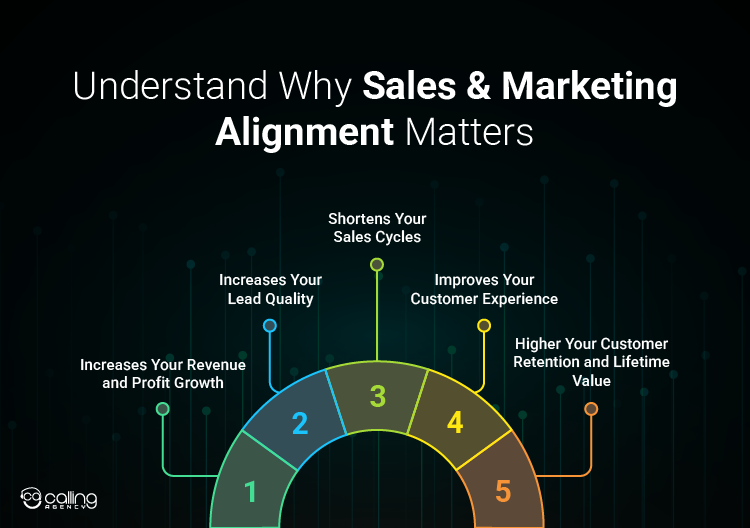
Increases your Revenue and Profit Growth
Your company can easily generate a steady pipeline of high-quality leads that are far more likely to convert with aligned sales and marketing efforts. This alignment not only improves sales win rates but also creates consistency in closing deals more frequently. You can see a sustainable increase in your revenue and growth as well.
Increases your Lead Quality
Your aligned teams can create a well-defined picture of what an ideal customer looks like. Marketing in general focuses on generating leads to meet your sales criteria. This also reduces your wasted time on irrelevant prospects and ensures that your team spends more energy on opening doors for new customers.
Shortens your Sales Cycles
You can speed up your buyer’s journey from the initial contact to closing the deal with clear and consistent communication. Your prospects get the right information at the right time that helps them make decisions faster. Ultimately, this alignment increases the efficiency of your cycle length and shortens your overall sales cycle.
Improves your Customer Experience
Customers today expect a seamless experience at every interaction with your brand. When you combine your strategy with marketing and sales, including constant messaging and support at every touchpoint, you can ensure a consistent and valuable customer journey. It improves customer satisfaction and loyalty toward your brand.
Higher your Customer Retention and Lifetime Value
It’s not just about winning customers; it’s also about keeping them. You can nurture long-term relationships by staying engaged with your customers even after the initial sale through your aligned marketing and sales efforts. Consistent follow-ups, personalized campaigns, and ongoing value-added services can certainly increase your customer retention rates and customer lifetime value.
Step-by-Step Alignment Framework
The importance of sales and marketing alignment in B2B sales isn’t simply unreasonable. They are the backbone of your high-performing B2B teams. Research has shown that companies with strong alignment have a 36% higher customer retention rate and a 38% higher sales win rate.
If these two teams come together, it ensures that you have synchronized efforts towards your specific target, driving more pipeline conversions, maximizing the ROI, etc.
It involves an alignment framework, in which you can find shared buyer personas, a handoff process, personalized goals and KPIs, transparent communication, and more.
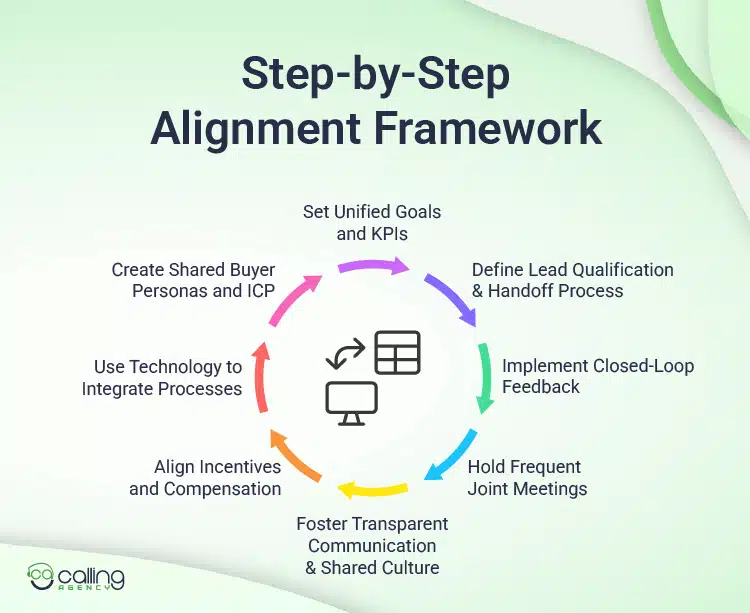
Create Shared Buyer Personas and ICP
When every customer is unique, identifying the common characteristics in your target audience can clearly help you determine your ideal customer and buyer persona for your business. You will exactly know where to allocate your time and resources depending on your customer.
An ideal customer profile is mainly used in B2B contexts. It’s a theoretical prospect that defines your customer’s attributes that perfectly match your company’s desired results.
Meanwhile, the buyer personas are the imaginary people who represent your decision-makers and stakeholders of your company. Your marketing teams need them to curate the touchpoints in order to create a better customer experience.
Develop your Ideal Customer Profile
- You can analyze and review your data from your existing customers. You can look for common features in demographics, psychographics, geographic, and behavioral traits.
- You can identify the key characteristics of your ideal customer companies using their size, industry, revenue, etc, based on your data and research.
Create your Buyer Personas Within The ICP Framework
- Engage with your customers through interviews or surveys to collect data about their preferences, goals, challenges, communication style, etc.
- Review your customer data and models, and you can create detailed buyer persona profiles within your ICP framework that represent each segment. You can include background information, buying behaviours, pain points, and more.
Foster your Sales and Marketing Alignment
- Prepare a shared document for your ICP and personas, so that they can be easily accessible to your marketing and sales teams.
- Utilize these shared profiles to guide your sales outreach activities, content creation, marketing campaigns, and product development for a customized experience.
Set Unified Goals and KPIs
Your teams can focus on different priorities without shared objectives, which can cause you less productivity and inefficiencies. Your marketing team may only focus on your long-term brand visibility, while your sales team may focus on your short-term revenue.
You can set combined goals that both teams can use and measure success, like developing shared KPIs. Key metrics, like marketing qualified leads (MQL), customer conversion, pipeline velocity, etc, can help you track performance that reflects both teams’ shared goals and priorities.
Develop your Unified Key Performance Indicators (KPIs)
- Determine your shared KPIs that can measure your customers’ entire journey and each team’s contribution to it.
- You can include KPIs like customer conversion rate, marketing-qualified leads, sales-qualified leads, etc.
Customer Conversion Rate measures how effectively your marketing leads are turned into paying customers. It represents the percentage of your potential customers who have taken a specified desired action.
CRR = (No of Sales/ No of Qualified Leads) x 100
Let’s say your Saas company has generated 80 leads through the website, and 20 of them have turned into buying customers. Your CRR will be:
CRR = (20/80) x100 = 25%
Your customer conversion rate is 25%, which is great for your Saas company.
Sales Qualified Leads generally refer to those leads that have a probability of converting into a buying customer. If your SQL has shown interest in buying and met certain lead qualification criteria, then this is considered suitable to advance to the next phase in the sales process.
SQL to Customer Conversion Rate = (Total Customers Won in a Year / Total SQL generated in a Year) x 100
Let’s say your sales team has generated 500 leads in the previous year and the number of customers they have won is 50. Your calculation is:
SQL to Customer Conversion Rate = (70/500) x 100 = 14%
Your SQL to Customer Conversion Rate is 14%.
Marketing Qualified leads indicate those potential customers who have been identified by marketing as having a higher chance of becoming paying customers. You can generate MQL through various marketing activities, like website visits, content downloads, etc.
MQL-to-SQL Conversion Rate = (Total SQLs in a year/ Total MQLs generated in a year) x 100
Let’s consider that your marketing team ran several campaigns and a total of 1200 leads met the criteria to become designated MQLs throughout the year. Out of those 1200 MQLs, your sales team conducted follow-up calls and determined that 300 leads were qualified for a direct sale opportunity. Your calculation will be:
MQL-to-SQL Conversion Rate = (300/1200) x100 = 25%
Your MQL-to-SQL Conversion Rate is 25% over a year.
Review and Adapt Regularly
- Monitor your shared goals and KPIs to ensure they remain relevant to your company’s strategic goals and improve your overall business performance.
- By evaluating them regularly, you can adapt your KPIs and align them with your evolving business priorities for better collaborative efforts.
Define Lead Qualification & Handoff Process
It is essential to determine a common lead qualification process for your sales and marketing optimization. When you set clear criteria for lead scoring and qualification, both your teams can make sure that they are targeting the accurate prospects and shift their complete focus on winning high-quality leads.
After collecting the specific data or metrics, your marketing team can pass the responsibility to the sales team to check the lead’s quality as a sales-qualified lead. If it qualifies, your sales team can create an opportunity and win the lead, or they can send the lead back to the marketing team for more nurturing.
Define your Qualification Criteria and Lead Stages
Both your teams must collaborate and clearly specify the different stages and the specific criteria for a lead to move from one stage to the next.
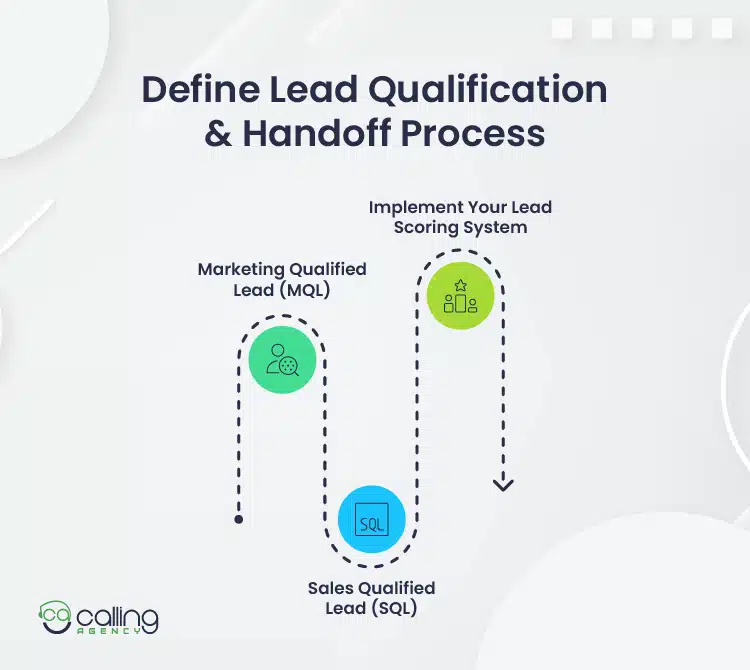
Marketing Qualified Lead (MQL)
An MQL lead has shown interest and engagement with your marketing campaigns, but has not been reviewed by your sales team.
- Ideal Customer Profile Fit
Identify the characteristics of those companies or individuals who are most likely to buy from you. These common attributes include company size, industry, location, etc, which align with your ICP.
- Engagement Activities
Your lead has taken specific actions, such as downloading your content, viewing pricing pages, attending a webinar, opening a specific number of newsletters, etc.
Sales Qualified Lead (SQL)
SQL is when your sales team has accepted a potential customer after it has met certain qualification criteria. This basically involves further reviewing based on a qualification framework.
Common qualification frameworks for SQLs:
BANT: Budget, Authority, Need, and Timeline. It basically means that if the prospect has financial resources, decision-making power, real problems or challenges, and a deadline for making a purchase decision.
CHAMP: Challenge, Authority, Money, and Prioritization. It generally focuses on your prospect’s biggest business problems, identifies who is responsible for the final purchase decision, determines the budget that your prospect has allotted, and assesses the importance of solving the challenge.
GPCT: Goals Plan, Challenge, and Timeline. It tries to understand what your prospect is trying to achieve, explores the specific strategies that your prospect has in mind, identifies the issues that your prospect is facing, and inquires about the timeframe that your prospect is working within.
Implement your Lead Scoring System
A lead scoring system generally assigns a numerical value to leads based on their behaviours and characteristics. This technically helps your sales team prioritize the most engaged and best-fit leads for sales.
- Assign Points
You can set award points for positive actions, like attending a webinar. Let’s say you have assigned +20 points to those who have attended the webinar.
- Reduce Points
A lead’s score can help you reduce negative actions or characteristics. For instance, you’ve deducted 10 points from one of your leads for removing payment information.
- Set A Threshold
Your leads can be automatically appointed through a threshold as an MQL and enter the handoff process without any difficulty.
Map and Automate your Handoff Workflow
A specified and seamless workflow can assure you that your leads are flowing effortlessly from your marketing to your sales team.
- Lead Reaches MQL Threshold
It indicates that your lead has reached a predetermined score or engagement level. It signifies enough interest and potential fit for further sales follow-ups.
- Marketing Review
One of your marketing team members may perform a final check on the lead’s quality. This ensures that the lead has a high possibility of becoming a paying customer.
- Automated Notification
Your marketing automation system or CRM automatically notifies your sales team that one of your MQLs is ready to follow up.
- Sales Acceptance or Rejection
Your sales representative will accept or reject the lead. If they reject a lead, they will send it back to your marketing team with a reason.
Implement Closed-Loop Feedback
A feedback loop makes sure your marketing and sales team isn’t completely operating on guesswork or unchangeable plans. Rather, it becomes adaptable.
Your teams can easily improve their strategies by regularly gathering feedback from customer service responses, online reviews, or social media interactions.
Without a proper feedback loop, both of your teams can spend months on a single campaign, only to learn that it didn’t hit the milestone.
Establish your Foundation of Alignment
Before implementing your feedback loop, you need to make sure that your sales and marketing teams are aligned on core business objectives.
- Determine your Goals and Key Performance Indicators (KPIs)
Instead of separate goals, your teams can focus on joint metrics that impact your revenue, like pipeline value, conversion rates, customer lifetime value, etc.
- Create your Service Level Agreement (SLA)
You need to prepare SLAs for each team’s responsibilities to explain what specifies your marketing qualified lead (MQL), B2B marketing, what actions your sales team must take, and how a lead must be contacted.
Connect your Technology Stack
Your combined technology stack is the engine of your closed-loop system, automating the flow of data between your sales and marketing teams.
- Integrate your CRM and Marketing Automation Platforms
This connection is important for tracking your lead’s journey from initial interaction to final purchase. Various systems offer seamless integration facilities.
- Implement Marketing Automation Tools
These types of tools provide a detailed view of each of your marketing touchpoints, like social media ads or blog posts that contribute to sales.
Capture and Share your Data Systematically
Develop clear processes for how your sales team will report back to your marketing team and how the information should be used.
- Implement Feedback Mechanisms with the CRM
Help your sales rep provide specific feedback on lead quality and conversion success directly in the CRM system. You can include a simple drop-down menu, like “poor fit”, or “high quality”, etc.
- Conduct Post-Deal Reviews
Evaluate both your closed-won and closed-lost deals to understand exactly what is influencing the outcome. Your marketing team can gain insights into messaging effectiveness, and your sales team can learn from objections and successful pitches.
Hold Frequent Joint Meetings
Marketing and sales alignment is becoming important in this modern age landscape, and your marketing leaders often seek ways to support the partnership and improve performance.
An effective way to do that is by holding sales and marketing periodic meetings to ensure the ongoing alignment between these two groups. The primary goal is to arrive at a common understanding and agreement on strategies, expectations, tactics, and performance.
Shared Vision and Goals
- Both of your teams can develop shared key performance indicators (KPIs), such as the quality and quantity of leads needed to hit your revenue goals. In that way, they can both hold each other accountable.
- Your regular sessions can assist your teams in developing and executing a unified strategy. In this way, you can ensure that all efforts are dedicated to the same objectives.
Improved Communication and Feedback Loops
- Your sales team can provide you with direct and unfiltered feedback from customers regarding your product or service. These can help your marketers refine their messaging, identify customer pain points, and create more effective content.
- Marketers can share data on your campaign performance, customer behaviour, and market trends. This can help your sales representatives improve their approaches, handle objections, and personalize interactions.
Higher Quality Leads and Content Effectiveness
- Combine your marketing’s demographic data with on-the-ground customer insights from sales. With such information, your teams can create and refine effective buyer personas.
- Your sales representatives can inform your marketing team about which materials work best with your determined prospects. This will ensure that your marketing produces valuable content, like case studies and product demos, etc.
Foster Transparent Communication & Shared Culture
A shared culture within your sales and marketing team is more crucial than ever before. It serves as the foundation for building trust, promoting partnership, and driving innovation.
Transparent communication is the cornerstone of any successful team. Creating an environment of open and honest communication within both your teams bridges the gap effectively. It also supports clear and shared communication that drives productivity and success in your organization.
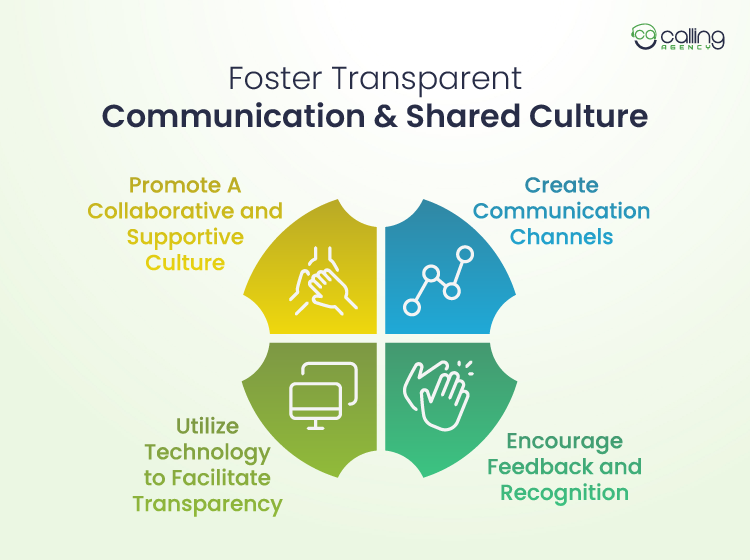
Create Communication Channels
- Regular Meetings
Schedule your regular meetings at weekly or monthly intervals between your sales and marketing teams. You can use these meetings to discuss strategies, share work updates, and provide valuable feedback to overcome challenges.
- Internal Communication Channels
Use technology like internal social networks or communication tools like Slack or Microsoft Teams to create dedicated channels for sharing daily updates and information.
Encourage Feedback and Recognition
- Regular Feedback
Regular feedback can help your sales and marketing teams on their respective performances. It would be better if you use the sandwich method, like starting your feedback with a positive response, then adding some constructive criticism, and finishing with another positive response.
- 360-Degree Feedback
You can also apply a 360-degree feedback system where both your teams can receive feedback about their work from their peers, managers, and subordinates.
Utilize Technology to Facilitate Transparency
- Collaborative Tools
Variety of tools, such as project management platforms and CRM systems can you assist you in promoting transparency. These tools can also help you improve collaboration, track progress, and share information effortlessly.
- Share Analytics
Provide both your teams with access to shared analytics and reports to assist them in making data-driven decisions. This is how you can also encourage open communication and continuous improvement.
Promote a Collaborative and Supportive Culture
- Team Building Activities
Organize your team-building activities, such as outdoor activities, joint lunches, or a company dinner, etc. It will help your team members to connect and understand each other better to build trust and harmony.
- Celebrate Joint Successes
Recognize and celebrate team and individual achievements that result from the joint efforts and hard work of both sales and marketing. You can also highlight their success stories and promote a supportive culture.
Align Incentives and Compensation
Sales compensation is one of the best practices that helps your business align pay with performance, motivate the sales and marketing teams, and drive predictable revenue growth.
A compensation plan is a structured strategy that shows how your sales professionals are paid based on their performance. It acts like a motivational tool and a financial model that drives desired sales behaviours. Essentially, sales compensation majorly aligns with your sales rep incentives and business goals.
Define your Shared Revenue Goal
- Traditional compensation plans that measure marketing on lead quality and sales on closed deals can create conflict. Create a unified approach that aligns both your teams around shared top-line objectives.
- For example, base a portion of your sales and marketing bonuses on your total quarterly revenue or a specific new business metric. When both your teams win or lose together, they are incentivized collaboratively as well.
Balance your Base Salary and Variable Pay
- An effective compensation structure uses a mix of base salary and variable incentives. It motivates and rewards both your sales and marketing teams.
- A mix of 70/30 (70% base salary and 30% variable) or 60/40 is a common compensation structure for sales reps. Furthermore, a smaller portion of compensation can be variable and tied to collective, company-wide revenue goals for marketers.
Incentivize your Collaborative Behaviour
- You can offer shared bonuses to both your teams for exceeding the joint KPIs, such as revenue from a co-developed campaign or a new retention rate.
- Generate special performance incentive funds (SPIFF) by running short-term, cross-departmental sales contests to focus on specific, high-priority objectives, like selling a new product or entering a new market.
Use Technology to Integrate Processes
Staying ahead in today’s fast-paced world, especially in modern business, means involving tools that can help you make smart marketing plans and drive faster sales. As a business owner, if you’re looking to scale, improve efficiency, and close more deals, sales technology should be your secret weapon.
The sales team usually uses a collection of software and technologies to increase sales productivity and close deals faster. It can be called a sales stack.
By adopting essential technologies like the CRM system, marketing automation tools, data analytics, etc, you can ensure a flexible collaboration between your sales and marketing teams, as well as a simplified workflow.
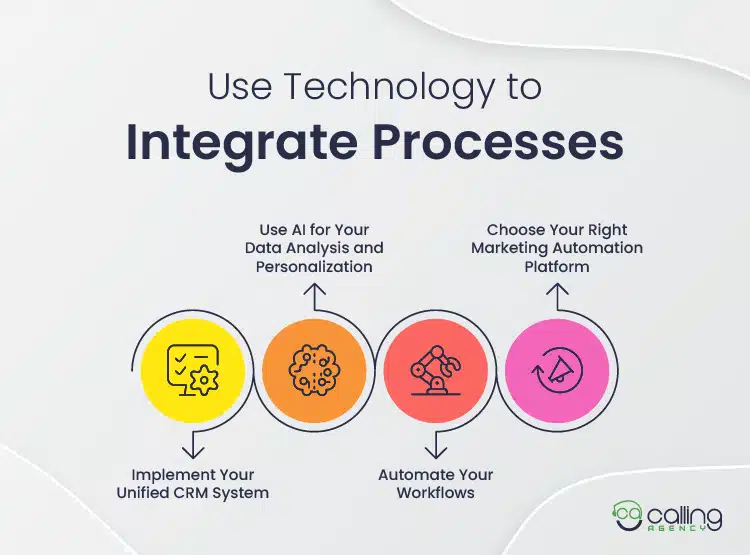
Implement your Unified CRM System
- A customer relationship management (CRM) system serves as a valid source. It gives both your sales and marketing teams a unified view of customer interactions and data.
- CRM platforms can help you manage your entire customer journey, from lead generation and nurturing to sales closing and ongoing customer support. It streamlines your entire sales process more efficiently.
Use AI for your Data Analysis and Personalization
- AI tools can analyze your large volumes of customer data to pinpoint patterns, preferences, and behaviours. These tools can also provide you with more informed and effective strategies.
- AI can assist you in creating personalized marketing content, such as email drafts, social media ideas, video scripts, etc. It helps your teams to focus more on strategic growth.
Automate your Workflows
- You can use automation to manage your routine tasks, like B2B sales lead generation, lead scoring, and sales follow-ups. With the help of AI, you can ensure the timely management of your collaborative prospects.
- Automate your repetitive processes to free up valuable time for your sales and marketing professionals. This helps them focus on higher-level strategic activities without any delay.
Choose your Right Marketing Automation Platform
- Platforms with automation capabilities can nurture your leads through personalized content delivery and targeted campaigns based on their behavior and interests.
- These AI tools can help you in creating and managing integrated marketing campaigns that align with your sales efforts. You can also improve your overall campaign effectiveness in this way.
Supporting Tactics & Advanced Approaches
Following the challenging years, aligning sales and marketing has become a major priority for almost every company, especially those in B2B businesses.
A report by InsideView shows that 54% of surveyed companies expect that their sales and marketing teams will transition into a single RevOps (Revenue Operations) unit.
Like most business areas, your sales and marketing may have agreement and cooperation at various tactical and strategic levels. This can include Accounting-Based Marketing (ABM), building a revenue team structure, and other advanced approaches.
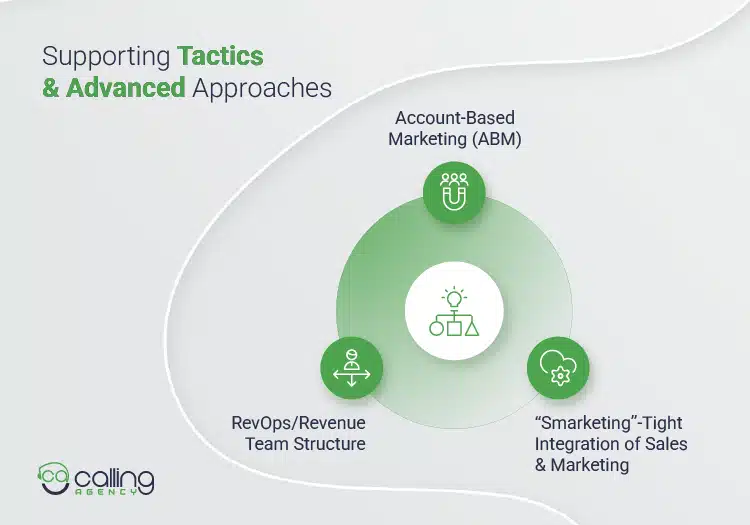
Account-Based Marketing (ABM) for Precision Targeting
Account-Based Marketing (ABM) has appeared as a key strategy for B2B organizations that are looking for targeted and personalized engagement with their most valuable accounts.
ABM mostly needs close teamwork between the sales and marketing teams to identify and target high-value targets effectively.
It creates a unique alignment between your sales and marketing efforts and focuses on high-value accounts to maximize resources and craft experiences that connect with key decision-makers.
Define and Agree on your Ideal Customer Profile
First thing you can do is jointly define the characteristics of your most valuable customers for your sales and marketing teams. This will create a shared understanding of what a “good fit” account looks like.
Identify your Key Characteristics
Analyze your best existing customers to pinpoint common traits, like:
- Filmographics: Industry, company size, revenue, and location
- Technographics: The technology stack they have
- Pain Points: Specific business challenges your ideal customers face
- Intent Signal: Topics they’re researching online, indicating a need for your major solution
Tier your Target Accounts
Not all your high-value accounts need the same level of attention. Segmenting them allows you to align your effort and resources with an account’s potential value.
● Tier 1 (One-to-One)
A small number of your high-value accounts, such as Fortune 500 companies, can receive highly personalized campaigns and direct sales outreach.
● Tier 2 (One-to-Few)
A larger segment of your mid-value accounts that you’ve combined together based on common attributes, like industry or pain points. For each group, every marketing campaign can be customized to their specific needs.
- Tier 3 (One-to-Many)
A broader set of accounts that fit your ICP is not of high value. This tier uses scalable, automated marketing tactics, e.g., based on tech stack or job titles, with a personalized touch.
Map Out your Stakeholders and Their Pain Points
Once you have your target accounts, both your teams must work together to identify the key decision makers within each organization.
- Uncover Pain Points
After researching each account and consulting with your sales team, your marketing team can create messages and content that directly address the specific challenge of each stakeholder.
- Create Account Intelligence
Share this information through a centralized CRM to create a consistent and relevant buyer experience across your every touchpoint.
Execute your Coordinated Multi-Channel Campaigns
Successful ABM requires a strategic launch across the channels your target uses most of the time. Both your sales and marketing teams must play an active role in the execution.
- Targeted Ads
You can use advertising platforms, like Meta Ads (Facebook/Instagram), or Microsoft Advertising, to deliver personalized ads, specifically to your target accounts.
- Personalized Email
You can automate your campaigns with a custom intent,e.g., offers or product recommendations that speak to each account or persona.
- On-site Personalization
You can use A/B testing tools to dynamically change your website content based on which target account is visiting.
Build a RevOps/Revenue Team Structure
A revenue operations (RevOps) team is a great way to ensure that your sales and marketing teams are working together toward achieving the same revenue goals. It simplifies your workflows by using data to make better decisions and improve efficiency.
RevOps is one of the fastest-growing departments within a business. A recent survey found that 53% of small businesses already have a formal Revenue Operations (RevOps) team in place.
Despite the wide variety of RevOps structures, you can build your own RevOps team based on the critical roles, revenue department, revenue function, and more.
The Foundational Approach
Before building your team, you must understand your current state and set a clear vision for the future.
- Audit your Revenue Engine
Plan your existing sales, marketing, and customer service workflows. This way, you can identify your inefficiencies, overlaps, and blockages.
- Map your Customer Journey
Define and standardize the stages of your customer journey lifecycle to ensure a seamless and consistent experience from the initial stage of lead generation to customer retention.
Choose your Revops Team Structure
For your RevOps team, the best structure depends on your company’s size and needs. The two most common models are by function or by department.
Model 1: Structure by Revenue Function
You can use this model group of specialists based on their area of expertise, allowing you deep specialization and cross-departmental teamwork.
This structure is best for those companies that want to avoid departmental silos and promote a holistic perspective.
- Your business intelligence specialists and data analysts can work together to provide insights across the entire customer journey.
- Your project manager and process specialists can work collaboratively to refine and simplify the workflow for all revenue teams.
- Your CRM administrators and software experts can work as a team and manage the entire tech stack together.
Model 2: Structure by Revenue Department
This model can help you create a dedicated RevOps sub-team for each of your revenue departments.
It is best for those organizations where operational professionals are already established in sales, marketing, and customer service. It allows a more straightforward position.
- MarOps (Marketing Operations) focuses on marketing efficiency, technology, and campaigns.
- SaleOps (Sales Operations) manages sales enablement, forecasting, territory planning, and the sales stack.
- CSOps (Customer Service Operations) focuses mainly on customer retention, renewal processes, and the customer service tech stack.
Embrace “Smarketing”—Tight Integration of Sales & Marketing
Your sales and marketing can gradually improve your customers’ experience with your brand and your bottom line. However, you can feel it is virtually impossible to create optimal sales + marketing (Smarketing) alignment without the right tools and techniques.
The term “Smarketing” was introduced in the early 2000s by HubSpot. The newly developed concept describes the alignment between your sales and marketing teams created through frequent and direct communication.
Smarketing’s foundation lies in transparency. It basically indicates that both your team’s shared and individual goals should be openly discussed and established in the customer experience.
Create your Shared Vision with Aligned Goals
- The foundation of your Smarketing is to have a unified target with a clear set of goals, a clear and aligned strategy, and a common understanding of the customer.
- Set your common key performance indicators that are focused on your business performance, rather than departmental metrics, like “ lead generation” for marketing, or “closed deals” for sales.
- Align the metrics that you will track together, including lead quality, conversion rates, and customer retention.
Implement your Service Level Agreement (SLA)
- A formal contract between your sales and marketing can set clear expectations for lead handoff and follow-up, holding both your teams accountable.
- Your marketing team agrees to provide a specific number of qualified leads. It can be based on mutually defined criteria.
- Your sales team agrees to engage with those leads and turn them into potential customers within a given timeframe.
Adopt a Shared Funnel
- Instead of separate funnels, you can create a single funnel that both your teams can work on for the customer journey. This ensures a smooth handoff and consistent message from prospects to customers.
- At the top of the funnel (ToFu), your marketing team can create brand awareness and generate interest with valuable content.
- At the middle of the funnel (MoFu), your marketing team can nurture leads while your sales team can offer input to ensure that your leads are accurately informed before the final handoff.
- At the bottom of the funnel (BoFu), your sales team can take over the final closing process by using a consistent message and content provided by your marketing team.
Involve your Teams in Post-Sales Efforts
- Smarkeing doesn’t end with a closed deal. Your teams can work together to increase customer lifetime value by using marketing campaigns. They can promote retention, upsells, and cross-sells.
- Your teams can use post-sale customer feedback to refine strategies and improve the customer experience. This aligns them with customer needs, helps to identify friction points, and makes improvements to products and campaigns.
Conclusion
This blog is your solid roadmap to understanding why bridging the gap between sales and marketing is essential for every B2B company that is looking to achieve long-term success.
The key to sales and marketing alignment lies in setting the common goals that both your teams can work towards. These two teams need to work within an aligned framework while using integrated tactics and advanced approaches.
While doing so, your teams can implement a feedback system and foster a shared and harmonious culture with transparent communication, driving growth and efficiency.
FAQ
What Are the Best Practices for Sales and Marketing Alignment in B2B?
For B2B sales and marketing alignment, you can create shared goals, define a clear lead management process, and promote a culture of harmony and transparent communication.
How Does Misalignment Affect B2B Lead Generation?
Misalignment negatively affects your B2B lead generation by reducing lead quality and conversion rates. It also creates an inconsistent customer experience, wastes resources, decreases revenue, and ultimately increases customer acquisition cost.
What Role Does Content Play in Aligning Sales and Marketing?
Content is the core component for aligning B2B sales and marketing by providing both your teams with a shared foundation of knowledge and messaging. A unified content strategy can always assure you a seamless and consistent customer experience, from the initial marketing contact to the final sales interaction.
How Can Shared KPIs Strengthen B2B Sales-Marketing Collaboration?
Your shared KPIs strengthen your B2B sales and marketing collaboration by breaking down the silos, fostering a unified strategy, and creating mutual accountability.
Which Tools Improve Sales and Marketing Alignment in B2B?
You can use a combination of platforms and tools to improve your sales and marketing alignment in B2B, such as customer relationship management (CRM), marketing automation, sales enablement, data and analytics, and project management.
How Do Buyer Personas Connect Sales and Marketing Efforts?
Your buyer personas connect your sales and marketing with a shared and consistent understanding of the ideal customer. This aligns their efforts around a customer-centric strategy, moving both your teams towards a unified personalized approach.
Why Do B2B Organizations Struggle with Sales-Marketing Alignment?
Your B2B organization can struggle with sales and marketing alignment, primarily because of siloed teams, different goals and metrics, and a disconnection in understanding the customer.
What Frameworks Ensure Sales and Marketing Work Together?
You can use numerous frameworks to ensure that your sales and marketing teams work together effectively. You can use revenue enablement and smarketing, account-based marketing (ABM) and experience (ABX), customer journey mapping, integrated technology, and more.
How Does Account-Based Marketing (ABM) Depend on Alignment?
Your account-based marketing (ABM) is primarily dependent on alignment between your sales and marketing teams to succeed. Unlike traditional marketing, where your funnels mass-generate leads toward sales, ABM focuses on resources with a specific list of high-value target accounts.

